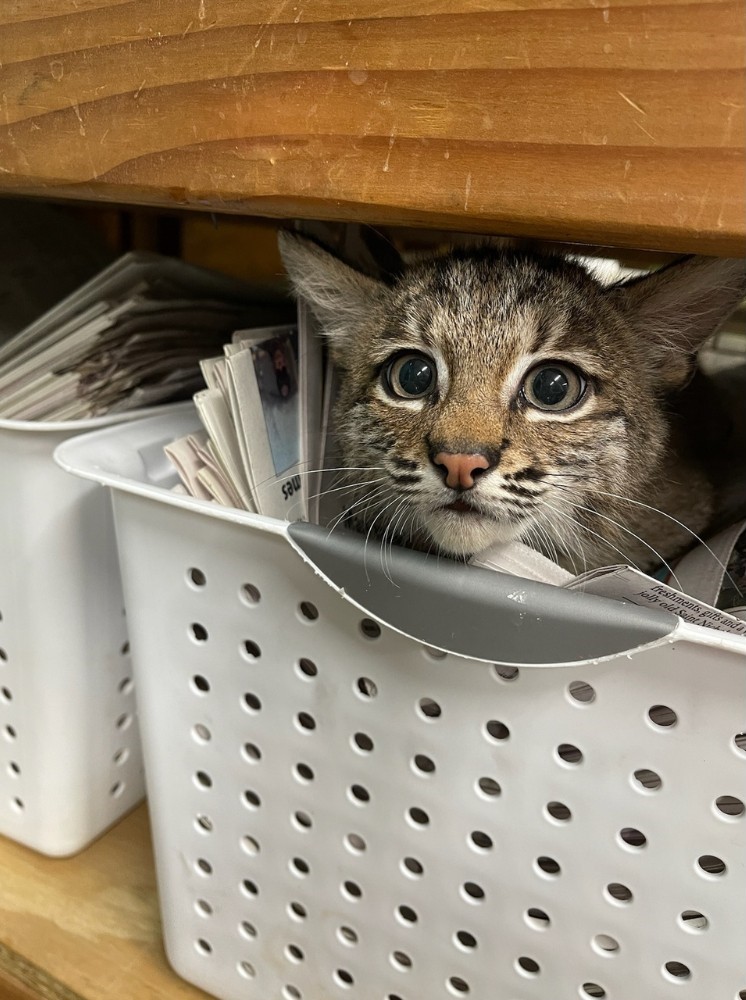📖 Table of Content:
In Oklahoma, a young bobcat has been given a second chance at life after rescuers discovered she had been raised like a household pet. Instead of prowling through woodlands, hunting small prey, and developing her natural instincts, she had been living indoors, surrounded by toys, furniture, and the sounds of everyday human life. For a wild animal, the setting was utterly unnatural.
When staff at Wild Heart Ranch, a licensed wildlife rehabilitation facility, first laid eyes on the bobcat, they knew right away that something about her behavior didn’t add up.
While most wild bobcats hiss, growl, or retreat at the sight of humans, this one acted like she was right at home. She approached calmly, made eye contact without fear, and even seemed eager to be close. She wasn’t stressed or panicked—she appeared to think she belonged in a house.
According to Annette King, the founder of Wild Heart Ranch, the caller who brought the animal in claimed they had cared for her for just two weeks. But her behavior told a much different story.
“You can’t create this level of human bonding in two weeks,” King explained. This bobcat had clearly spent months—if not most of her life—living in a human-centered environment. She had been imprinted on people, likely cuddled, handled, and treated as though she were a kitten rather than a wild predator.
A Difficult Situation for Rehabilitators
Wild Heart Ranch has been rescuing, treating, and releasing wildlife in northeastern Oklahoma since 1996. Every year, the facility takes in thousands of animals, from injured birds of prey to orphaned raccoons. The goal is always the same: heal them, prepare them for survival, and release them back into the wild where they belong.
But this bobcat presented an especially difficult case. By law, wildlife rehabilitators in Oklahoma are not permitted to keep wild animals indefinitely. They must either release them within a certain timeframe—typically around six months—or, if release isn’t possible, euthanize them. The rules are designed to ensure that wild animals remain wild, rather than becoming long-term captives.
That meant that the bobcat’s fate was uncertain. While she was physically healthy, her behavior posed a serious problem. Having been raised like a house pet, she lacked the sharp edge of caution and independence needed to survive.
Without fear of humans, she could approach people or wander into neighborhoods, putting both herself and others at risk. And without hunting instincts, survival in the wild would be nearly impossible.
Recognizing the seriousness of the situation, Wild Heart Ranch transferred the bobcat to another licensed rehabilitator. Fortunately, this facility had a wild bobcat cub of the same age. The plan was simple but hopeful: place the two animals together and allow the wild-born cub to teach the imprinted one what it means to be a bobcat.
Wild animals learn much of their behavior through imitation. Just as young domestic kittens watch their mothers to understand hunting and grooming, wild bobcats pick up survival skills by watching one another. If this rescued bobcat could mirror her wild peer, there was a chance she might relearn her instincts and reclaim her natural identity.
Lessons from the Rescue
This unusual case is a powerful reminder of why wild animals should never be treated like pets, no matter how adorable or seemingly harmless they may appear as babies. While people may take in young creatures with good intentions, such as “saving” them or providing comfort, the long-term consequences can be devastating.
For the animal, the loss of its wild instincts often means losing the possibility of a free life. A bobcat that believes it belongs in a living room instead of the forest is not equipped for survival. It may starve, get injured, or become dangerously bold around humans.
For the people, keeping wild animals without proper permits and training can also be illegal and unsafe. Bobcats are strong, unpredictable predators, even at a young age. Their claws and teeth can inflict serious injuries, and their behavior can never truly be domesticated.
The moment a wild animal is taken into a home, its future hangs in the balance. Every hour it spends bonding with humans makes rehabilitation harder. Every day away from the wild makes release less likely. And once the legal window closes, the options become limited.
Still, there is hope for this young bobcat. Living alongside a wild peer may spark a transformation, reminding her of instincts buried beneath months of human contact. If she adapts, there is a chance she will eventually roam free, hunting and surviving as nature intended. If not, she may face a life in captivity—or worse, depending on how authorities assess her ability to reintegrate.
Stories like this highlight the tireless work of rehabilitators, who not only treat injured animals but also navigate the complex emotional and ethical challenges of working with creatures caught between two worlds. Their mission depends on public awareness: people must resist the urge to treat wild animals as pets and instead contact professionals immediately when one is found.
In the end, this bobcat’s journey is more than a rescue story—it’s a lesson in respect for the wild. She may have lived like a house cat for months, but with the right guidance, there is still a chance for her to remember she was born a bobcat, not a pet.


